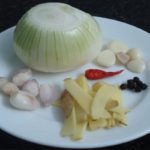
1 Mastering the Art of Boiling Chicken
Before boiling, add a touch of sugar, sliced shallots, ginger, green onion roots, and turmeric to the pot of water. This simple trick will infuse the meat with sweetness and moisture, resulting in a visually appealing golden hue.

When it comes to boiling, pour just enough water to submerge the entire chicken before turning on the heat. Avoid boiling the water first and then adding the chicken, as this may cause the skin to peel and tear.

Pro Tip: Skim off any foam that rises to the surface to ensure a whiter skin. This will create a stunning contrast when you brush on the turmeric later.
Once the water reaches a rolling boil, reduce the heat to low to prevent the skin on the chicken legs from shrinking and toughening the meat. Continue cooking for approximately 15 minutes before turning off the heat and covering the pot for a further 20 minutes. This ensures the chicken cooks evenly.

Pro Tip: Use a toothpick or a small skewer to pierce the thickest part of the thigh. If no red juices flow out, your chicken is perfectly cooked.
2 Achieving a Crispy, Golden Skin

Prepare a bowl of cold water and submerge the boiled chicken to rapidly cool it down and tighten the skin, preventing unsightly dark spots. Leave it in the water until the skin feels cool to the touch, then remove and drain.

For an aromatic and glossy finish, fry some chicken fat with turmeric, shallots, and garlic and brush this mixture over the skin.

3 Selecting the Perfect Chicken
Opt for a young rooster with a bright red comb, yellow legs, and a full breast. This ensures tender meat and golden skin.
Look for thin, elastic skin free from any strange odors and bruising. Avoid chickens with dark, discolored skin, as this indicates the bird has been dead for some time before processing.
To spot water-injected chickens, press your finger into the thigh or breast—if it retains an indentation, it’s best to choose another bird.
With these tips, you’re well on your way to becoming a master of boiled chicken, impressing your family and friends with both flavor and presentation.
More Useful Advice for Homemakers (Part 2)
Have you heard of the surprisingly easy tips to make cooking and household chores simpler? White radish eliminates the acrid taste of salted meat, adding alum to raw shrimp helps soften it, and adding cold water when frying eggs can make them crispy – these are just a few of the tricks to make your life easier.
Ten Strategies to Streamline Your Cooking Process
Are you a busy housewife looking for ways to save time in the kitchen? Did you know that flossing can also help you out? Check out these 10 tips to help you quickly and easily prepare delicious meals for your family. Learn how to peel garlic in 10 seconds and cut cherry tomatoes quickly for a healthy and tasty meal.




































